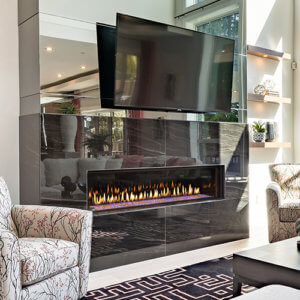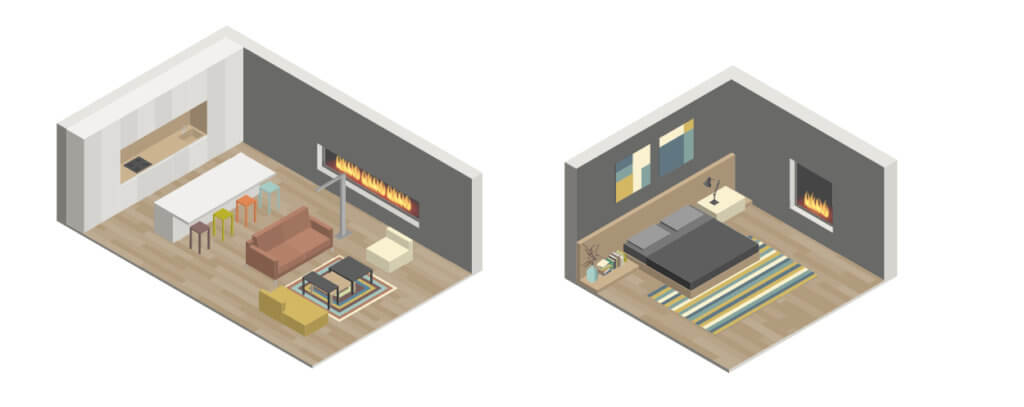Sometimes Retro is Awesome, Sometimes it Needs an Intervention
The 90’s brought us many great things – from Milli Vanilli and inflatable furniture, to fanny packs and crop tops.
The decade also gave us a great generation of beautiful fireplaces that warmed our homes as we watched the OJ Simpson car chase. But the time has come to replace those dated fireplaces with newer models that offer higher efficiency, better features, and a more current look. Retrofitting a fireplace is the latest must-have upgrade!
Here are a few key items to consider when retrofitting an existing direct vent fireplace…
Reasons for a Retrofit
There are quite a few reasons to update an existing direct vent fireplace. Common triggers for a retrofit include a visual update (hello brass louvers!), new fireplace technology, home automation compatibility, and rebate offers from the government or energy company.
A few more reasons to retrofit include….
Safety
Young families moving into older homes are immediately noticing that an older fireplace poses a variety of safety concerns. Sharp exposed louvers and units with no safety screens pose a safety risk to small children. Replacing those fireplaces with something more family-safe is high on the priority list.
Home Efficiency
Along with replacing single pane windows and drafty doors, homeowners should consider their fireplace chase an item to remedy for home efficiency. Modern codes dictate that a chase on an outer wall be properly insulated. Combining a code update with a high efficiency fireplace can create a great benefit to energy savings.
A Smaller Footprint
Square footage is becoming more and more valuable. Installing a shallower unit such as the DelRay Linear (only 14 ¼” deep) can help reduce the encroachment on the living space while still providing an impressive fire display.

All of these points should be considered along with the most important reason of all: aging gas appliances should be replaced at regular intervals for safety reasons.
Dimensions of the Fireplace and the Fire-space
In addition to a homeowner’s personal preferences, the physical size of the fireplace itself should be considered when speccing out an installation. For instance, a space with a long wall and shorter ceilings might be more suited to a linear fireplace. Whereas taller rooms or a squared wall might be more appropriate with a traditional shaped fireplace.
Dimensions for Retrofits
When the proposition of a retrofit comes into light, significant time and money can be saved if attention is paid to the goal of having the least amount of adjustments made from the exiting installation to the new one. This can be done in a few ways…
Vent Height
For rear vented units, if the vent center on the new unit is the same (within 1/2″) as the old unit, then a lot of installation headaches can be avoided. Generally the same vent exit point can be used as long as new venting and termination is used. Pay close attention to building codes that might have changed since the time the last fireplace was installed, as other adjustments might need to be made to the framing structure.
Vent Size
If the replacement unit is dedicated 5/10 venting then you might have a difficult task using the same vent route as a unit that used 5/8 or 4/7.
Framing & Finishing
Even when taking modern building codes into account, many new fireplace models can be retrofitted into the existing framing of the previous unit. With this in mind, be sure to check for damage or wear to the current framing and review the clearances for the replacement unit.
The fireplace finishing material is generally not salvageable from the previous install. This can be a positive as new developments have permitted many new finishing options, such as wood facing for the DelRay Square, and the elimination of requirements for a noncombustible hearth.
Home Owners Associations
Also known as Strata Associations in Canada, HOAs can be a headache for condo owners and installers alike. HOAs can complicate many larger scale retrofit projects. Items to consider during the fireplace selection and quoting process should include:
What’s Behind That Wall?
A project can go off the rails completely if a project is approved with units on-site, and then when the wall is opened up you discover plumbing, or even structural members in the way of your planned install. Best practice is to not finalize a model choice for retrofit or provide a final quote until you know exactly what is inside the wall.
Façades
Some HOAs may have requirements for how the fireplace termination looks on the outside of the building. Often they will insist that the existing termination must be used in order to continue the look of the building, or have specific requirements on the termination paint color.
Next Steps
Now that you’ve got the basic considerations covered, it’s time to call in the professionals. A Montigo authorized dealer in your area can help you take the next steps.
